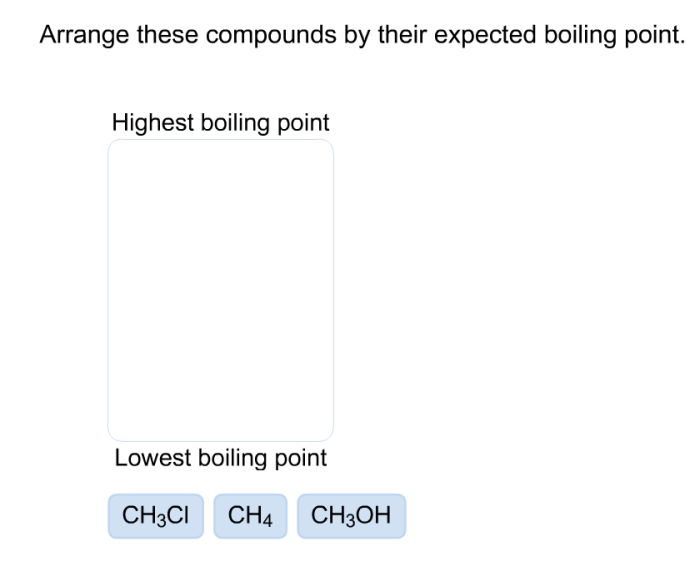Arrange these compounds by their expected boiling point. – Boiling point, a fundamental property in chemistry, plays a pivotal role in understanding the behavior of compounds. This comprehensive guide delves into the concept of boiling point and its influencing factors, providing a step-by-step procedure to rank compounds based on their expected boiling points.
By examining intermolecular forces and their impact on boiling point, we gain insights into the molecular structure and properties of various substances.
Through a detailed analysis of compound properties, this guide empowers readers to predict and compare the boiling points of different compounds, enhancing their understanding of chemical behavior and its applications in diverse fields.
Boiling Point: A Measure of Intermolecular Forces: Arrange These Compounds By Their Expected Boiling Point.

The boiling point of a compound is the temperature at which it transitions from a liquid to a gas. This phenomenon occurs when the vapor pressure of the liquid equals the pressure of its surroundings. Understanding boiling points is crucial in chemistry, as it provides insights into the strength of intermolecular forces (IMFs) within a compound.
Factors influencing the boiling point of a compound include molecular weight, polarity, and the presence of IMFs. Heavier molecules tend to have higher boiling points due to their increased mass, while polar molecules exhibit stronger IMFs and thus higher boiling points compared to nonpolar molecules.
Identifying Intermolecular Forces
IMFs are attractive forces that exist between molecules. The strength of these forces determines the physical properties of a compound, including its boiling point. Common types of IMFs include:
- Hydrogen bonding: A strong IMF formed between a hydrogen atom bonded to a highly electronegative atom (N, O, F) and another electronegative atom.
- Dipole-dipole interactions: Forces between polar molecules with permanent dipoles.
- London dispersion forces: Weak, temporary forces that arise due to the instantaneous polarization of electron clouds.
Ranking Compounds by Boiling Point
To rank compounds based on their expected boiling points, follow these steps:
- Determine the molecular weight of each compound.
- Assess the polarity of each compound. Polar compounds have stronger IMFs than nonpolar compounds.
- Identify the presence and strength of IMFs within each compound. Hydrogen bonding is the strongest IMF, followed by dipole-dipole interactions and London dispersion forces.
- Rank the compounds in order of increasing boiling point, considering the combined effects of molecular weight, polarity, and IMF strength.
Creating a Table of Ranked Compounds
Organize the compounds in a table with the following columns:
- Compound Name
- Molecular Weight
- Polarity
- Expected Boiling Point
Example Analysis, Arrange these compounds by their expected boiling point.
Consider the following compounds:
- Methane (CH 4)
- Water (H 2O)
- Ethanol (CH 3CH 2OH)
- Diethyl ether (CH 3CH 2OCH 2CH 3)
- Hexane (CH 3(CH 2) 4CH 3)
Using the ranking procedure, we can arrange these compounds in order of increasing boiling point:
| Compound Name | Molecular Weight | Polarity | Expected Boiling Point |
|---|---|---|---|
| Methane (CH4) | 16.04 | Nonpolar | -161.6 °C |
| Hexane (CH3(CH2)4CH3) | 86.18 | Nonpolar | 68.7 °C |
| Diethyl ether (CH3CH2OCH2CH3) | 74.12 | Polar | 34.6 °C |
| Ethanol (CH3CH2OH) | 46.07 | Polar | 78.3 °C |
| Water (H2O) | 18.02 | Polar | 100 °C |
Advanced Considerations
While the general rules for ranking boiling points are useful, there are exceptions:
- Hydrogen bonding: Compounds with strong hydrogen bonding, such as water, have unusually high boiling points compared to similar-sized molecules.
- Resonance: Compounds with resonance structures, such as benzene, have lower boiling points than expected due to delocalization of electrons.
Essential Questionnaire
What factors influence the boiling point of a compound?
Molecular weight, polarity, and intermolecular forces are the primary factors that influence the boiling point of a compound.
How can I predict the boiling point of a compound?
By considering the molecular weight, polarity, and intermolecular forces of a compound, you can predict its boiling point using the ranking procedure Artikeld in this guide.
What are the different types of intermolecular forces?
The different types of intermolecular forces include dipole-dipole interactions, hydrogen bonding, and van der Waals forces.


